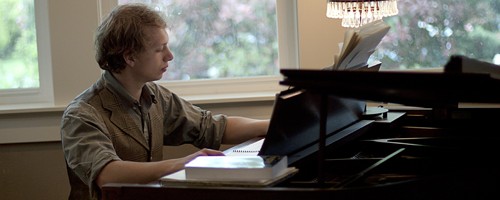In 2007, Mad Men made the ’60s cool again. The show’s influence can be found everywhere from Banana Republic—which enlisted the show’s costume designer to create a special collection—to dive bars (Adrian Grenier from HBO’s Entourage recently partnered with a Nike designer to release beers in flattop cans).
Leave it to Don Draper
In 2007, Mad Men made the ’60s cool again. The show’s influence can be found everywhere from Banana Republic—which enlisted the show’s costume designer to create a special collection—to dive bars (Adrian Grenier from HBO’s Entourage recently partnered with a Nike designer to release beers in flattop cans).

But Mad Men has sparked discussions about more than pencil skirts and vintage cocktails. The show’s ambitious, historically grounded plot lines and complex female characters have drawn attention from academics, including historian Stephanie Coontz, who called Mad Men “TV’s most feminist show” in a 2010 Washington Post article.
Coontz will deliver a lecture titled “Mad Men, Working ‘Girls,’ & Desperate Housewives: American Women at the Dawn of the 1960s” tomorrow evening in Smith Memorial Student Union.
Coontz teaches history and family studies at the Evergreen State College in Olympia, Wash., and is director of research and public education for the Council on Contemporary Families. She’s spent her career examining social norms, with a particular focus on the “traditional American family.”
“The 1960s are a time that some people look back nostalgically to and think that people were happier and marriages were more stable because there were more stay-at-home moms,” Coontz said.
Mythologizing the 1960s as “a golden era of ‘family values’” prevents our society from addressing the problems today’s changing families face. What’s more, Coontz notes that these idealized tableaus were profoundly damaging to the very families they purported to represent.
“In the 1960s, there were a lot of women who thought that if they weren’t happy, if their lives didn’t feel like a 1950s sitcom, that there was something desperately wrong with them,” Coontz said.
The 1963 publication of Betty Friedan’s The Feminine Mystique was something of a watershed: “Thousands of women read that book and recognized themselves,” Coontz said.
The women of Mad Men confront many of the same issues that Betty Friedan’s original readers confronted. The expanding economy of the 1960s created new opportunities for women in the workforce. At the same time, the 1960s saw the dawn of modern advertising, with Madison Avenue “ad men” aggressively marketing to prototypical housewives that, according to Coontz, were actually few and far between.
Coontz’s work describes an America that’s been in flux since its earliest days. She’s written on topics ranging from the history of marriage to the nuts and bolts of 1960s American households. Her interviews with women she calls “the real life desperate housewives of the 1960s” confirm that American homemakers of yesteryear looked more like Mad Men’s Betty Draper than Leave It To Beaver’s June Cleaver.
In one of the show’s early episodes, Betty, a seemingly ideal housewife, crashes her car due to a spell of numbness in her hands. Coontz points to this as an example of how Mad Men “picks up on stuff that really was happening.” Numb, shaky hands like Betty’s, Coontz explains, “were actually a recognized sign of the depression and hysteria that was called ‘housewives syndrome.’”
Like The Feminine Mystique, the show “speaks to a lot of the issues that help explain why women joined the women’s movement in the late 1960s,” Coontz said.
Other topics addressed on the show include marital rape (a female character’s fiancé assaults her at work—she goes out to dinner with him afterward), unequal pay for women and the dearth of realistic representations of women in advertising.
Coontz’s lecture will focus on the world Betty Friedan described in 1963 and how it stacks up to the issues today’s women face.
“When young people come to this talk, they’ll be absolutely stunned by the world their grandmothers lived in,” she said. “Women who wanted to work had to go through gender-segregated want ads…most jobs for women were looking for ‘perky girls to do typing.’”
One of Friedan’s central criticisms in The Feminine Mystique was that women who sought to become ideal homemakers “were so frustrated that they could only find success through their husband’s careers, and it made them nagging wives and unsuccessful mothers,” Coontz said.
This season on Mad Men, it’s 1966, and one has to wonder whether Peggy and Joan are taking their cues from The Feminine Mystique. Joan kicks her rapist husband to the curb and finally returns to work despite her new baby, while Peggy wonders if she acts too much like a man.
The two struggle to receive pay and recognition for their work at the agency, where their less-talented female coworkers continue sleeping with the boss to get ahead. On the home front, Betty Draper struggles with an eating disorder that threatens her trophy-wife figure, while her adolescent daughter deals with the aftermath of a divorce (and myriad other issues).
This month, Wisconsin repealed an equal pay law that made it less onerous for women to sue for fair compensation. Meanwhile, Ann Romney extols the virtues of housewifery on national television. Coontz’s lecture will investigate “what’s changed and what hasn’t” for women since the publication of Friedan’s book.
Stephanie Coontz: “Mad Men, Working ‘Girls,’ & Desperate Housewives: American Women at the Dawn of the 1960s”
Wednesday, April 25
5:30–7:30 p.m.
Smith Memorial Student Union (room 355)
Free and open to the public





